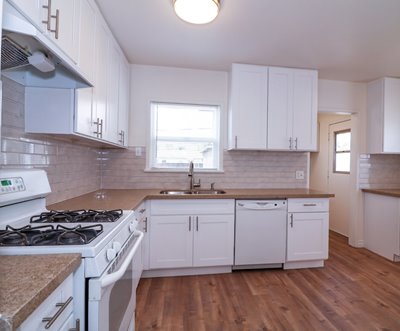Across the NeighborWorks network, nonprofits are working on new ways – and old ones – to create and preserve affordable housing. At NPHS Inc., a nonprofit community development organization in Southern California's Inland Empire, staff are examining shared equity housing, housing models that help make housing affordable for families with modest incomes. The homes remain affordable, too, for families down the line, while building equity for the owners. But the first thing they have to build is trust.
Shared equity models include limited-equity housing cooperatives, resident-owned manufactured housing communities, and community land trusts, where the homeowner would own the home, but a nonprofit would own the land beneath it. NPHS adopted that model, starting with a house they purchased at a discount through Fannie Mae. As they rehabbed the home, they also made it solar-ready, which plans a role in affordability, says Jenny Ortiz, vice president of design and development. It also showed they cared about the welfare of the new homeowners.
 NPHS purchased a home for the land trust just before the pandemic began. The goal was to find more houses that had gone into foreclosure and turn them into permanent, affordable housing. As foreclosure moratoria were set in place NPHS focused on the opportunity in hand, and began working on home repairs. Escalating housing prices were the next obstacle. The buyer qualified for a $240,000 home; the home itself appraised for $330,000, but a CLT appraiser used a formula to take into account the discount made to the homebuyer.
NPHS purchased a home for the land trust just before the pandemic began. The goal was to find more houses that had gone into foreclosure and turn them into permanent, affordable housing. As foreclosure moratoria were set in place NPHS focused on the opportunity in hand, and began working on home repairs. Escalating housing prices were the next obstacle. The buyer qualified for a $240,000 home; the home itself appraised for $330,000, but a CLT appraiser used a formula to take into account the discount made to the homebuyer.
In traditional homeownership, the point of sale is where the relationship would end. With a land trust, the relationship continues. Now, the nonprofit is helping the homeowner qualify for solar panels through the Single-Family Affordable Homes program (SASH.) "We're hoping when all is said and done, we'll have solar at no cost to the home buyer," Ortiz says.
The nonprofit is also hoping that showing continued interest in the property – and in the welfare of the homeowner – will establish even more trust as the relationship continues. "This is where the stewardship component steps in," says Andy Lopez, project coordinator. "Part of that stewardship is engagement."
Stewardship is a signature piece of shared equity work, since there is literally shared ownership at the root. Building trust is an important part of that stewardship, as the nonprofit helps support homeowners to stay in the home and ensure it remains a community asset over time.
To keep in touch with the homeowners, NPHS sends seasonal notes to residents – reminding them when there are risks of high winds, reminding them to clean up leaves and debris, making them aware of wildfire season, and more. "As we build the relationship, the intention is that if anything happened with this home, they'd be comfortable talking with us," Lopez says. "I've heard other people talk about it like this: ‘You're the developer that doesn't leave.' We want a relationship with the families we're helping provide housing for. In the future, if the family builds wealth and wants to buy in the traditional market, we want to be able to assist in that." Meanwhile, they'll assist in keeping the home affordable for the next buyer.
"NeighborWorks America is supporting shared equity homeownership models, like the community land trust, because they unlock homeownership for families who wouldn't otherwise be able to buy a home, and then make that same home affordable for future families over time," says Shanti Abedin, director of Shared Equity Housing at NeighborWorks America.
"We also know that, because the community or shared piece of shared equity housing brings in a longer-term support structure and stewardship element, participating families are far less susceptible to foreclosure or displacement," Abedin says. This piece of the equation is incredibly important in times of crisis and in markets when housing prices are skyrocketing, she adds.
NPHS's goal is to buy five to seven homes per year for their community land trust. While the pandemic and ballooning home prices have delayed their progress, they recently hired a new real estate development director and director of lending to focus on acquiring new properties. As foreclosure moratoria lift, there is a high expectation that homes in pre foreclosure now go into full foreclosure. In California, nonprofits will have some of the first opportunities to purchase those properties in the hopes they can create permanent affordable housing – something that did not occur during the housing crisis of 2008, when investors grabbed homes going into foreclosure.
NPHS is also looking at an infill scatter-site opportunity, where the goal is to attract infill development in distressed communities. The land would be donated, she says, making the homes they build a logical part of a land trust. They'll continue to look at solar opportunities there, too, as they work to move the needle in making homeownership affordable in the Inland Empire.
NeighborWorks America's training includes a course on Shared Equity and stewardship.

